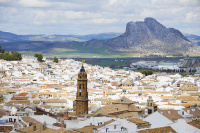
The historic cemetery of Villanueva de la Concepción |
|
Villanueva de la Concepción

Plaza de Andalucia
This handsome hill town, just 35 minutes north of Málaga and 20 south of Antequera, is described as "al pie del Torcal", 'at the foot' of the El Torcal Natural Area. This is a remarkable 17km-square region of limestone rock formations eroded by wind and rain that might lmost be described as Andalucía's answer to Uluru, the original name now used for Australia's Ayer's Rock. Some 100 million years ago the entire region was deep below the Mediterranean, and only gradually hefted above sea level by seismic activity that continues today across Andalucía. Nowadays there is a small visitors' centre, car park and signposted walking routes through the area.
The Torcal landscape has attracted tourists for many years, some of whom have bought properties in town and countryside, and Villanueva de la Concepción is used to welcoming visitors. There are many restaurants and bars in the town, which remains quite small, with a population of around three thousand. Its elevation at roughly 500m above sea level gives it an ideal climate, mixing the heat of the Costa with fresh mountain breezes. Tourism here tends to be 'turismo rural', in country cottages and hostales, and a handy new campsite with cabins and a pool popular with visitors and townsfolk alike.
A selection of hand picked holiday villa rentals in the countryside around Antequera from Rustical Travel.
All with private pools and grounds.
There is a theory, supported by local archaeological excavations of prehistoric stone tools, that hunter-gatherers were living in the Villanueva area as long ago as 60,000BC, and that Neanderthal man established cave dwellings here before 5,000BC. Certainly, there has been a human settlement on the site of Villanueva de la Concepción since 200BC, when Roman invaders established a small town which they called Oscua. Ruins of Roman villas can still be seen today, and there are vestiges of a forum, a theatre and a burial ground. Oscua was obviously an important early settlement, and so close to the major port to the south. Roman artefacts have been discovered in a swathe of land ten kilometres across around Villanueva, suggesting widespread habitation.
Villanueva was taken by the Moors shortly after their invasion in 711AD. They built the nearby castle, el Castillo de Xébar, for defensive reasons in the wars that swept across Andalucía for the best part of 800 years. The castle also guarded one of the key crossroads from the north down to the coast. It was taken by the Christians in 1410, by an army led by the Infante Don Fernando, who reinforced the castle while the Reconquest still raged for another 78 years, during which time Villanueva was a frontier garrison. After the Reconquest, the castle lost its military importance and was abandoned. At this time, the Spanish settlement was known as Cuesta del Palmar, hill of the palm-growers.
In the 18th century, the route running past Cuesta del Palmar was turned into a "Camino Real", 'royal way', between Madrid and the coast, and various bridges built around the town, now renamed Villanueva de la Concepción. Arriving from Málaga, you will cross the older El Puente del Horcajo - Horcajo bridge, horcajo being the Spanish for the land between the point where two rivers meet. It was built in 1786. The bridge crossing the neighbouring rio (river) Campanillas was built a year later in 1787, as recorded in an inscription on the bridge, which was constructed from a single arch spanning the river.
Villanueva was a small hamlet and only declared a village by decree from the Málaga government in 1880, when it established a number of new townships in the region to attract settlers. As an incentive, the sons of the settlers were exempt from military service, and no taxes were levied on any agriculture. Agriculture is still its economic mainstay, although tourism is developing here.
The most important festivals in Villanueva de la Concepción are the February carnival, the town's summer Feria around August 15 and the official anniversary of the establishment of Villanueva de la Concepción on November the third.





